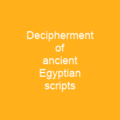Egyptian temple

Egyptian temples were built for the official worship of the gods and in commemoration of the pharaohs. The most important part of the temple was the sanctuary, which typically contained a cult image. Dozens of temples survive today, and some have become world-famous tourist attractions.
About Egyptian temple in brief
 Egyptian temples were built for the official worship of the gods and in commemoration of the pharaohs. The most important part of the temple was the sanctuary, which typically contained a cult image, a statue of its god. A divine presence in the temple linked the human and divine realms and allowed humans to interact with the god through ritual. With the coming of Christianity, traditional Egyptian religion faced increasing persecution, and temple cults died out during the fourth through sixth centuries AD. Egyptologists continue to study the surviving temples and the remains of destroyed ones as invaluable sources of information about ancient Egyptian society. Dozens of temples survive today, and some have become world-famous tourist attractions that contribute significantly to the modern Egyptian economy. The participation of the general populace in most ceremonies was prohibited in Egypt in the ancient period. There were also other gods who had significant roles in the cosmos, but no significant presence in temple ceremonies or private practice, with little or no religious practice or magical practice in the temples for the most part. The temples are among the largest and most enduring examples of ancient Egyptian architecture, with their elements arranged and decorated according to complex patterns of religious symbolism. They were meant to be places for the gods to reside on earth, and to maintain the ideal order of nature and of human society in Egyptian belief.
Egyptian temples were built for the official worship of the gods and in commemoration of the pharaohs. The most important part of the temple was the sanctuary, which typically contained a cult image, a statue of its god. A divine presence in the temple linked the human and divine realms and allowed humans to interact with the god through ritual. With the coming of Christianity, traditional Egyptian religion faced increasing persecution, and temple cults died out during the fourth through sixth centuries AD. Egyptologists continue to study the surviving temples and the remains of destroyed ones as invaluable sources of information about ancient Egyptian society. Dozens of temples survive today, and some have become world-famous tourist attractions that contribute significantly to the modern Egyptian economy. The participation of the general populace in most ceremonies was prohibited in Egypt in the ancient period. There were also other gods who had significant roles in the cosmos, but no significant presence in temple ceremonies or private practice, with little or no religious practice or magical practice in the temples for the most part. The temples are among the largest and most enduring examples of ancient Egyptian architecture, with their elements arranged and decorated according to complex patterns of religious symbolism. They were meant to be places for the gods to reside on earth, and to maintain the ideal order of nature and of human society in Egyptian belief.
The buildings they left behind suffered centuries of destruction and neglect, but they still provide important information about the ancient society. They are still an important tourist attraction today, as well as a source of income for the Egyptian economy and culture. They have been the subject of several films, including “The Temple” and “The Seven Wonders of the Ancient World,” both of which are based on the works of Frida Ghitis and directed by Michael O’Neill. The film is based on a novel by Ghitis, which is published by Simon & Schuster and is scheduled to be released in April 2014. It is available on DVD and Blu-ray, with a suggested MS-ray release date of April 14, 2014. For more information on the “Seven Wonders” series, visit www.thesevenkellyshows.com or call the National Museum of Egypt in Cairo, Egypt, on 1-800-273-8255 or visit http://www.museum-of-egyptian-history.org/the-seven- Wonders-of the-Ancient-Egyptian-society-and-culture/ The Seven Wonders of the Ancient World Series on YouTube is also available on YouTube and on the company’s website, www.cnn.com/channel/seven-hellos-the-eight-hours-theseven-halls-theeight-hills-the seventh-hundreds-and first-years-of. The series also airs on PBS stations on Sundays at 9 p.m. ET and 9 a.m., ET. ET on weekdays on PBS and PBS stations on PBS stations.
You want to know more about Egyptian temple?
This page is based on the article Egyptian temple published in Wikipedia (as of Oct. 31, 2020) and was automatically summarized using artificial intelligence.












